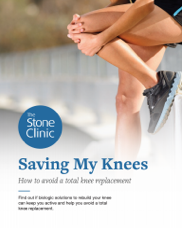Articular cartilage transplant to the trochlea rehab protocol
Articular cartilage transplant to the trochlear rehab protocol
- Weight bearing as tolerated in full extension with brace for 4 weeks post-operatively.
- Patients are cleared to drive once they are off all narcotic pain medications typically around week 2, or if cleared by Physical Therapist. Can unlock brace while in car.
- Regular manual treatment should be conducted to decrease the incidence of fibrosis.
- Regular stretching of the posterior musculature is important to prevent a flexion contracture. Although ambulating in full extension, some loss of motion prior to surgery is not uncommon.
- Imperative to work on recruiting VMO throughout the rehab process.
- No resisted leg extension machines (isotonic or isokinetic) at any point.
- No patella mobs for 4 weeks.
- Low impact activities for 3 months post-operatively.
- Use of the CPM (Continuous passive machine) for 6 hours a day for 4 weeks. Range of motion is 0-100 degrees for the first 4 weeks. Gradually work up to 100 degrees as patient tolerates.
- Avoid direct palpation of the surgical portals for 4 weeks. Consider the edges of the bandages as the “do not touch” zone (approximately 2” in all directions from each portal).
Week 1
- Nurse visit day 2 post-op to change dressing and review home program.
- Icing and elevation regularly per icing protocol.
- Continuous passive machine (CPM) at home for 6 hours daily during wake hours.
Manual
- Soft tissue mobilization (STM) to quadriceps, posterior musculature, suprapatellar pouch, popliteal fossa, ITB (iliotibial band), Hoffa’s fat pads.
- No patellar mobs x 4 weeks.
- No direct palpation of surgical portals x 4 weeks.
Exercises
- Well-leg stationary cycling, upper body ergometer (UBE).
- Straight leg raises (standing, supine, side lying), quadriceps/ gluteal sets, hip and ankle exercises.
- Seated dangle with opposite leg support within appropriate range of motion.
Goals
- Passive range of motion 0 to 70 degrees.
- Gait weight bearing as tolerated in full extension brace x4 weeks post op.
Weeks 2 - 4
- Nurse visit at 14 days for suture removal and check-up.
Manual
- Continue with soft tissue mobilization to quad, posterior musculature, suprapatellar pouch, popliteal fossa, ITB, Hoffa’s fat pads.
- No patellar mobs x4 weeks.
- No direct palpation of surgical portals x4 weeks.
Exercises
- Proprioception exercises.
- Non weightbearing aerobic exercises (i.e. unilateral cycling, UBE, single leg row machine).
- Manual resisted proprioceptive neuromuscular facilitation patterns of the foot, ankle and hip.
Goals
- Passive range of motion 0 to 100 degrees.
- Gait weight bearing as tolerated in full extension brace x4 weeks.
Weeks 4 - 6
- M.D. visit at 4 weeks post-operative, wean off use of rehab brace.
Manual
- Continue with soft tissue mobilization to quadriceps, posterior musculature, suprapatellar pouch, popliteal fossa, ITB , Hoffa’s fat pads.
- Can initiate gentle patellar mobilizations and scar mobilization if incisions closed > 4 weeks post op.
Exercises
- Incorporate functional exercises (i.e. short arc squats, slider lunges, shuttle squats/Pilates board squats and exercises, calf raises). Balance/proprioception exercices.
- Progress into bilateral stationary cycling and continue to add light resistance as tolerated.
- Slow to rapid walking on treadmill (preferably a low-impact treadmill).
- Pool/deep water workouts once surgical portals are completely closed.
Goals
- Knee flexion 110 degrees.
- Gait: full weight bearing, unlock brace/wean off brace, focus good mechanics with minimal assistive device.
Weeks 6 - 8
Manual
- Continue with soft tissue mobilization and scar tissue mobilization as needed.
Exercises
- Bilateral stationary cycling and progress to road cycling on flat roads.
- Initiate pool/deep water exercises.
- Gradually increase the range of motion of closed- and open-chain exercises.
- Add lateral training exercises (i.e. side-stepping, Theraband resisted sidesteps) once adequate strength has been demonstrated.
Goals
- Patients should be walking without a limp. Range of motion 0 to 120 degrees.
- Ascend stair step at 8 inch height.
Weeks 8 - 12
Manual
- Continue with soft tissue mobilization and scar tissue mobilization as needed.
Exercises
- Increase the intensity of functional exercises (i.e. add stretch cord for resistance, increase weight with weight lifting machines for upper body, avoid loading with knee flexion type activities- weighted squats).
- Road cycling as tolerated, remain in saddle, slow cadence, no clip in type shoes until > 12 weeks.
Goals
- Full range of motion symmetrical to opposite lower extremity.
- Descend stair step at 8 inch height, descend hills with good control.
Weeks 12+
- Sports Test 1 at 12 weeks
- Continue with strengthening, endurance, balance, and sport specific training.
- Increase intensity of low impact type cardio- swimming, cycling, elliptical,etc.
- No high impact activities until 1 year unless approved by MD.
6 months +
- Appointment with MD. Will receive further instructions at this time.
All progressions are approximations and should be used as a guideline only. Progression will be based on individual patient presentation, which is assessed throughout the treatment process.

